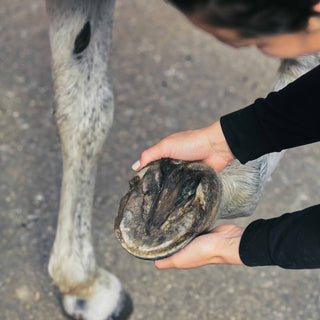Basic information on hooves that break out
Broken hoof wall - now what? Broken hoof walls are a serious problem for the health and performance of horses. In this guide you will learn all about the causes, symptoms and treatment options for this common hoof problem. We give you valuable tips.
What are broken hooves?
Broken hooves have cracks or splinters in the wall horn of the hoof. This damage can be superficial or penetrate deep into the wall horn and affect both shod and barehoofed horses. Broken hoof walls impair the function, statics and stability of the hoof and can also lead to pain and lameness in advanced stages.
Broken hoof walls, whether shod or barehoofed, always have one or more causes. In the following, we explain how this horn damage occurs, how it can be prevented and, if it is already too late, how it can be treated effectively.

Fig. 1: Severe wall breakouts in the area of the nailing
Why do hooves break out?
Originally, the horse is a steppe animal and therefore, due to evolution, more suited to sandy, dry terrain.In our latitudes, horses' hooves often come into contact with a lot of water over long periods of time (wet paddocks, paddocks, frequent washing) and, when kept in stables, even with good stable hygiene, with a damaging mixture of urine, excrement and ammonia.
This constant moisture leads to rotting of the horn in the long term. Especially in shod horses, as the moisture often remains under the shoe for a very long time. In bare hoofed horses, however, a deepened white line can also form. This mainly affects the frog horn and the horn of the white line. Both areas consist of soft horn and are much more susceptible to rotting processes than the firmer hard horn of the wall and sole.
This means that the decay-causing germs (fungi and bacteria) are the first to cause damage in these areas, known as thrush and white line disease (WLD).These rotting processes can also persist over longer dry periods, as horn decomposition produces harmful substances that can in turn dissolve the horn. This includes, for example, hydrogen sulphide with the typical rotten-egg smell of thrush. This is a kind of vicious circle that needs to be broken.
Loose iron, broken nails
In shod horses, the area of the weight bearing edge and the white line is covered by the shoe for the entire shoeing period and can only be treated by the farrier when the shoe is changed. This means that the harmful germs have 6 to 8 weeks undisturbed time during the shoeing period to decompose the horn of the white line in an optimal environment for the germs. The covering of the horseshoe provides moisture, darkness and airtightness. In addition, the hoof provides warmth and the stable bedding has an alkaline pH value. This creates ideal living conditions for the germs.
Several generations of nail holes
In the shod horse, this causes damage in the white line up to the nail area. This is facilitated by the weakening of the wall due to the old and new nail holes.
The result is nails breaking out and loose or lost shoes, which then leave large parts of the hoof wall hanging. Even a good farrier has little chance of hammering in durable nails. When re-nailing, the nails tear into the old nail holes. These nails are no longer resilient. If an iron is already loose, the wall becomes increasingly unstable.
If it is no longer possible to nail it properly, a glue-on shoe or a switch to bare hooves is required.
However, the hoof nails themselves can also accelerate the breaking out of the hoof walls. The farrier must always shape the shoe so that the nails penetrate the soft horn of the white line first and only after a few centimetres into the harder hoof wall. If the nail is driven into the harder hoof wall too early or immediately, it has a strong spreading effect there. This can then lead to cracking. Very low nailing can also lead to cracks. If the nails are placed correctly, the elasticity of the horn can absorb the spreading effect. Sometimes, however, the hoof shape, extreme sensitivity or various types of horn damage make it impossible to place the nails optimally.

Fig. 2: An iron like this doesn't last long
Removing loose iron
Each new generation of nail holes weakens the hoof wall. In principle, this is not a problem. In a healthy hoof, enough horn always grows back to allow the farrier to nail in new, load-bearing horn when trimming.
If additional shoes are required during the shoeing period due to loose or lost shoes If new nails are put in, the wall quickly loses stability.Loose shoes, even if they only wobble slightly, destroy a lot of horn because the nails are cross-loaded by the hoof sliding on the shoe. This means that the nail holes expand laterally and lead to further cracks and breakouts. A loose shoe should therefore be correctly nailed back on or removed as quickly as possible to prevent further horn damage.
Bare hooves are also affected
With bare hooves there are of course no problems with the nailing. In this case, the hoof shape, mechanical values and the terrain have an influence on hoof stability. However, the processes involved in horn decomposition caused by germs and harmful substances take place in exactly the same way.

Is the fault in the care?
Very often, such damage is interpreted as "hooves that are too dry" and the advice is to water a lot and then grease them. Unfortunately, however, this approach is counterproductive, as watering is extremely conducive to rotting processes.
As a general rule, hooves damaged in this way should be kept dry, as the germs that cause this love moisture. No fats or oils should be used for treatment, as these trap the germs. Soaps should not be used for cleaning, not even curd soap. Soaps are alkaline and promote horn decomposition.
Only the Keralit Hoof Strengthener should be used. For larger breakouts, the hoof strengthener should be applied every one to two days; in less severe cases, once or twice a week is sufficient. It is important to apply the hoof strengthener to the largely dry hoof so that the horn can absorb the hoof strengthener well. If the hooves are washed beforehand, they soak up water and therefore absorb less of the hoof strengthener. The horn should therefore only be brushed dry with a hard brush before cleaning.

Fig. 4: Horn wall damage that has grown down well thanks to consistent care with the hoof strengthener
At every appointment, your hoof trimmer should remove the defective horn, which is only loosely attached to the hoof and has no load-bearing capacity, as far as possible. In this way, the damaged areas underneath can be be achieved more effectively.
Causes of breaking hooves summarized
Hooves break out due to a variety of factors:
- Moisture: In our latitudes, horses' hooves often come into contact with water over long periods of time, e.g. through wet paddocks, paddocks and frequent washing. In the long term, this constant moisture leads to rotting processes on the horn, especially in shod horses, as the moisture remains under the shoe for a long time.
- Decay processes: Moisture favors rotting processes caused by bacteria and fungi, which attack the soft horn of the white line and the frog.
- Shoeing: In shod horses, the weight bearing edge and the white line are covered by the shoe for the entire shoeing period, which favors the accumulation of moisture and harmful germs. Old and new nail holes further weaken the hoof wall.
Diagnosing a hoof wall fracture
A hoof wall fracture is usually diagnosed by visual inspection of the hoof. Typical symptoms are visible cracks or splintering of the hoof wall, but the damage in the white line is often much more extensive than is immediately apparent. An experienced farrier or vet can examine the severity of the hoof wall fracture in more detail and recommend appropriate treatment measures.


